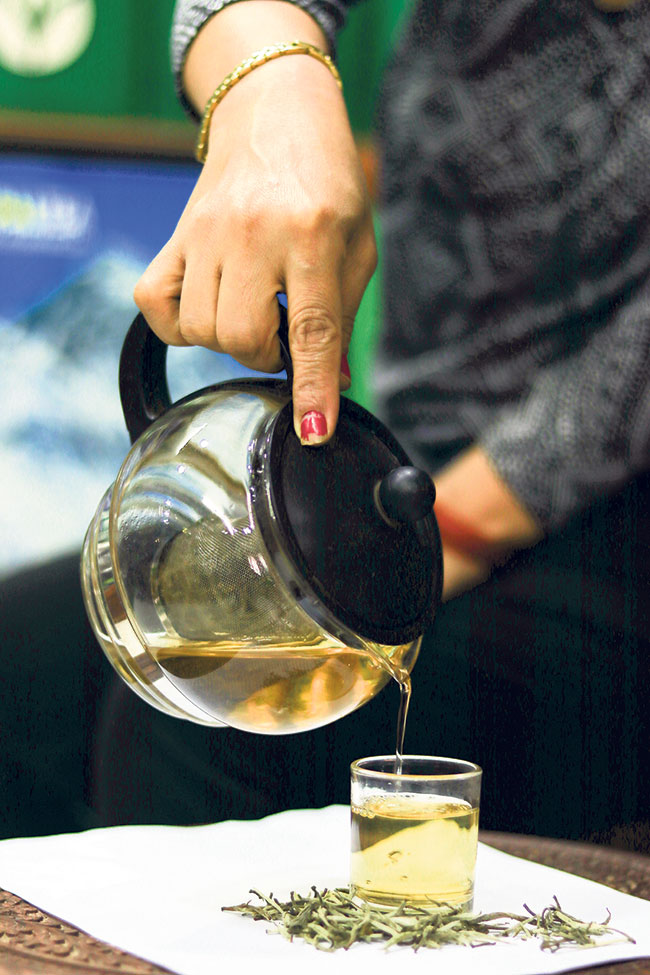'Chakka Panja' team and Paul Shah announce financial aid for daily wage film technicians
4 years ago
keyran8lama@gmail.com
KATHMANDU, Sept 30: Tea has been the beverage of choice served in honor of guests. However, with the changing time, its purposes have also diversified. In the Nepali society, though tea was primarily consumed to stimulate energy, it has gained prominence for its vast health benefits.

Tea is found in several varieties. From CTC tea to orthodox leaf variances, each has their distinct consumption and preparation method. However, connoisseurs agree that the widespread method, which involves sugar, is not only incorrect but also tampers with the original flavor.
No Sugar Please
Navin Maharjan of Himalayan Tea Corner at Newroad further attested to the fact that adding sugar in tea kills its actual flavor. To inform about the damages, on the taste, caused by sugar, he has put up a notice board in his shop that reads: ‘Sugar kills the actual taste of the tea’.
Tea fanatics avoid sugar. The misconception of sweet enhancing taste has led to the rest adding heaping spoons of sugar into the beverage. “Tea should stimulate taste buds. Drinking tea without sugar gets the mouth to start watering. It helps refresh the mind,” said Maharjan adding, “If our taste buds get a hint of sweet flavoring, we cannot determine other taste.”
He also mentioned that unsweetened tea is beneficial for digestion.

The eastern part of Nepal consists of several tea processing factories. They are known for producing orthodox and Crush Tea Curl (CTC) tea.
Orthodox tea is created from Camellia sinensis – a smaller species of leaf tea. It is the key source of different variances like white tea, green tea, black tea, and oolong tea. Camelia -- an assamica plant, with its origins in Assam, India – is used to produce CTC tea.
White tea
White tea is delicate and rare. It has less caffeine -- compared to other orthodox tea. Generally, it is hand-picked and hand-processed. The leaves of white tea have distinct silver tips; therefore it is also known as silver tip tea. The insignificant amount of caffeine gives it a light color. It produces a smooth flavor with raw aroma.
Processing
White tea is non-fermented and rolls like other tea which is just plucked from the tea garden. It is naturally dry.
Benefits
White tea contains a higher amount of antioxidant. It helps rejuvenate mind and at the same time boost metabolism. It also has antibacterial agents and anti-aging characteristics.
Oolong tea
Oolong tea is a popular beverage in Taiwan and China.
It has both characteristics of black and green tea. It is semi-fermented tea which is present in different models. The tea is either rolled into small-tight ball or twisted into thin strands. In Nepal, only twisted thin strands oolongs are available. It has a grassy aroma.
Processing
When the buds are plucked from the tea garden, they are shrunk. About 60% of leaves become dry. Then, a tea master starts rolling and twisting the leaves into balls or thin strands. The roll determines the aroma and taste of oolong tea. Later, it is left for oxidization. Finally, the leaves are partially roasted before rolling one last time.
Benefits
Oolong tea is appropriate for people with low blood pressure. It boosts metabolism and is good for the heart, brain, and oral health. It also has anti-cancerous properties.
Green tea
Green tea is gaining popularity among Nepali consumers. It is fermented less than oolong or black tea. Green tea has a yellowish green color.
Processing
The tea is either steamed or pan-panned in the machine. Next, the workers wither and roll the tea. In the end, it is dried to reduce moisture.
Benefits
Green tea helps reduce fat. It is best consumed after meal.
Black Tea
Orthodox black tea is the common tea variety in Nepal. It is fermented more than other tea varieties to give it its dark color and fermented flavor.
Processing
The tea is withered right after plucking. Then it is rolled and fermented. It undergoes further processing to gain a strong flavor.
Benefits
Since black tea contains antioxidants such as flavonoids, it is good for cardiovascular health. Also, polyphenols in the tea have anti-cancerous properties.
-Use fresh and cold water while brewing.
-Different tea varieties need different temperature. White, green and oolong are delicate. Excessively hot water will bruise their leaves and give bitter taste. So, the best method is to infuse at a lower temperature. 80 degree is the preferred temperature. For black tea, crank up the heat.
-Use one spoon or two grams of tea for a cup.
-Leave tea in hot water for 4 to 6 minutes before serving.

Leave A Comment